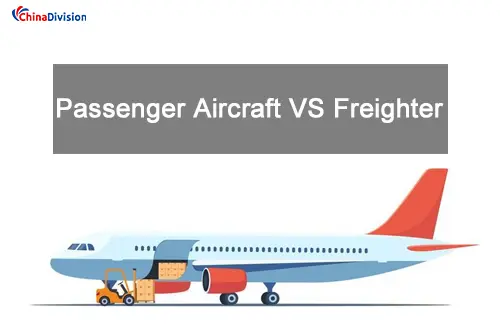Difference Between Passenger and Freighter Cargo in Air Transport
As an efficient and fast logistics method, air transport has become a key choice for many B2B companies and e-commerce sellers to ensure the stability of the supply chain. However, in the actual operation of air transport, many customers are confused about whether to choose passenger aircraft or cargo aircraft for cargo transportation.
Table of Contents
This article will start from the professional perspective of international logistics fulfillment service providers, combine the core differences between Freighter Cargo and Passenger Air Transport, analyze the advantages and applicable scenarios of the two, and provide feasible solutions to help companies optimize logistics decisions.
Belly Cargo
Belly cargo transportation of passenger aircraft means using the cargo space in the belly of the passenger aircraft to transport cargo. While performing passenger transportation tasks, passenger aircraft loads cargo in the belly cargo hold to achieve passenger and cargo transportation. This mode of transportation is common in commercial flights. Its advantage is that it can use the route network of passenger aircraft to transport goods to all parts of the world.
Advantages
- Extensive route network: Passenger aircraft routes cover many cities and regions around the world, and can transport goods to remote or niche destinations, providing more flexible route options for cargo transportation.
- Relatively low transportation costs: Compared with special aircraft transportation, passenger aircraft belly cargo transportation does not require additional special aircraft operating fees, which reduces transportation costs. Especially for small and light goods, the cost advantage is more obvious.
- Good timeliness: Passenger aircraft flights have a high density and can provide more frequent transportation opportunities to meet some cargo transportation needs with high timeliness requirements.
Limitations
- Limited and unstable space: The space in the belly of a passenger aircraft is limited, and the space supply is unstable due to factors such as flight schedules and passenger occupancy rates. During peak seasons or special periods, there may be a situation where space is tight and cargo cannot be loaded in time.
- Cargo safety risks: During the transportation of cargo in the belly of a passenger aircraft, the cargo may be subject to risks such as bumps and squeezing, resulting in damage to the cargo. In addition, the delay and cancellation of passenger flights will also affect the timeliness of cargo transportation.
- Complex operation: The transportation of cargo in the belly of passenger aircraft involves coordination with airlines, airport freight forwarders and other parties. The operation process is relatively complicated and requires more time and energy for communication and arrangement.

Freighter Cargo
Freighter transportation means the use of aircraft specially designed for transporting cargo for cargo transportation. Freighters have larger cargo space, stronger load capacity and more flexible route arrangements, which can meet the transportation needs of large-scale and high-value cargo. Freighter transportation is usually operated by professional cargo airlines, providing direct services from the origin to the destination.
Advantages
- Strong cargo capacity: Freighters have larger cargo space and load capacity, can transport a large amount of cargo at one time, and are suitable for the transportation needs of large and heavy cargo.
- High transportation stability: Freighter flight arrangements are relatively fixed, not affected by passenger flight schedules and passenger load factors, and stable space supply, which can ensure that cargo is loaded and transported on time.
- Cargo safety is guaranteed: During cargo transportation, the cargo is more professionally packaged and fixed, the transportation environment is relatively stable, and the risk of cargo damage is low.
- Customizable timeliness: Cargo transportation can arrange direct flights according to customer needs, provide more flexible transportation time options, and meet the timeliness requirements of different customers.
Limitations
- High transportation cost: Cargo transportation requires the payment of special aircraft operation fees, including aircraft leasing, crew fees, etc., and the transportation cost is relatively high. For small and light goods, the cost-effectiveness is low.
- Relatively limited route network: The number of cargo flights and route coverage are relatively small compared to passenger aircraft. Some remote or niche destinations may not be directly accessible and need to be transferred or combined with other modes of transportation.
- High operation requirements: Cargo transportation requires professional crew, ground operators and logistics facilities support, high operation requirements, and corresponding logistics resources and professional capabilities.
Passenger Air Transport vs. Freighter Air Transport
Transport Capacity and Space Design
Freighter Aircraft: Designed specifically for cargo transportation, without a passenger cabin, 100% of the capacity is used for cargo, with a large cargo hold capacity (200-600 cubic meters of cargo can be loaded at a time), equipped with a large cargo hold door (over 2 meters in height and over 3 meters in width), and supports the loading of heavy cargo such as pallets and containers. For example, wide-body freighters can carry extra-long and extra-heavy equipment, such as industrial molds and large machinery. Sufficient capacity, stable timeliness, and support for special cargo (dangerous goods, temperature-controlled medicines). However, the route depends on cargo demand, and remote areas need to transfer.
Passenger Aircraft: Use the remaining space in the belly of the passenger aircraft to carry cargo, usually accounting for 10%-15% of the total flight capacity, and mainly rely on the luggage hold (belly cargo) to transport small batches of cargo. The cargo hold door of a narrow-body passenger aircraft is narrow and cannot load oversized cargo. It is suitable for documents, samples, small items, etc. Covering a wide range of routes (depending on the passenger network), the unit price is low ($36/kg). However, the capacity is limited, the priority is low (passenger luggage is prioritized), and it is prone to delays during the peak season.
Loading method and efficiency
Cargo planes use lift platform trucks (ULD) for direct loading and unloading, which is efficient and suitable for large quantities of goods; passenger planes need to be loaded in batches through baggage conveyor belts, which takes a long time and needs to be coordinated with the flight schedule.
Safety and restrictions
Cargo planes can transport dangerous goods (such as lithium batteries and chemicals), but they must follow the IATA "Dangerous Goods Regulations"; passenger planes have strict restrictions on dangerous goods and only allow some specially packaged goods. In addition, cargo planes can carry environmentally sensitive goods such as live animals and precision instruments.
Applicable scenarios and solutions
High-value, urgent goods
Such as electronic products, fashion clothing, medical samples and other goods with extremely high timeliness requirements. Give priority to cargo plane transportation to ensure that the goods are delivered quickly and directly. For example, through the charter service of logistics providers, global delivery can be achieved within 24-48 hours.
Large and oversized cargo
Such as mechanical equipment, furniture, auto parts and other cargo that exceeds the standard in volume or weight. You can confirm cargo space with the logistics company in advance and customize the transportation plan (such as splitting the cargo and using special packaging). For example, the multimodal transport service for large and heavy cargo provided by ChinaDivision can combine air, sea, rail and other modes to reduce transportation costs.
Cost-sensitive cargo
Sending small batches of samples, low-value, light-weight goods (such as clothing and daily necessities). It is cheaper to use the belly of a passenger aircraft (PAX Cargo), but you need to pay attention to flight schedules and space restrictions. It is recommended to sign a long-term agreement with the logistics company to lock in space and prices.
Special cargo
Dangerous goods, live animals, temperature-controlled cargo (such as vaccines). You should choose a cargo operator with professional qualifications to ensure compliance with the International Air Transport Association (IATA) standards. For example, ChinaDivision's worry-free solution for battery products can provide compliant shipping services such as built-in batteries and power banks.
Popular Questions and Answers: Avoid the "Invisible Trap" of Air Transport
Why did passenger aircraft freight rates suddenly increase by 3 times?
During the peak passenger season (such as the Spring Festival and summer travel season), the belly cargo capacity is squeezed by passenger luggage, and airlines dynamically adjust prices. You can use Chinadivision's "off-season prepaid space" service to lock in fixed freight rates for the next 6 months.
How to avoid samples being detained by customs during passenger aircraft transportation?
The document should indicate "Commercial Sample, No Commercial Value"; declare HS Code in advance to avoid the value of goods exceeding the duty-free limit (such as US $800); choose DDP (Delivery Duty Paid) terms, and the logistics company will pay the customs duties on your behalf.
How to choose the right mode of transportation?
According to the nature, weight, volume, destination, timeliness requirements and cost budget of the goods, comprehensively evaluate the advantages and disadvantages of passenger aircraft belly cargo transportation and cargo aircraft transportation, and choose the most suitable mode of transportation. For small, light and time-sensitive goods, passenger aircraft belly cargo transportation is preferred; for large, heavy, high-value and time-sensitive goods, cargo aircraft transportation is preferred.
How to reduce transportation costs?
For belly cargo transportation of passenger planes, book space in advance, choose off-season or non-peak hours for transportation, and use bulk transportation discounts to reduce unit costs. For cargo plane transportation, optimize cargo packaging, reduce volume and weight, and reduce transportation costs. At the same time, rationally plan transportation routes to avoid unnecessary transfers and delays and improve transportation efficiency.
The core value of international logistics fulfillment service providers
As an international logistics fulfillment service provider, ChinaDivision provides one-stop solutions for enterprises with the following advantages:
Diversified transportation network: integrating 100+ global logistics partners such as DHL, FedEx, UPS, etc., covering 220+ countries/regions.
Customized service: providing multimodal transport solutions such as air, sea, and rail according to cargo attributes, tariffs, and timeliness requirements.
Compliance support: professional teams handle customs declaration and clearance matters to ensure that goods comply with the laws and regulations of various countries (such as EU CE certification and US FDA registration).
Digital management: through self-built ERP and WMS systems, order, inventory, and logistics information can be synchronized in real time, reducing the error rate to less than 1%.
Value-added services: Provide personalized services such as quality inspection, labeling, customized packaging, and last-mile delivery to enhance customer experience.
Whether you choose a passenger plane or a cargo plane, the key is to develop the best logistics plan based on the characteristics of the goods and business needs. Choosing the right mode of transportation is crucial to optimizing logistics costs and improving transportation efficiency. By understanding the difference between belly cargo transportation and cargo transportation, you can better choose the right mode of transportation based on the nature and needs of the goods. If you need more help, please contact Chinadivision. We will provide you with professional logistics services to ensure the smooth operation of your business.





